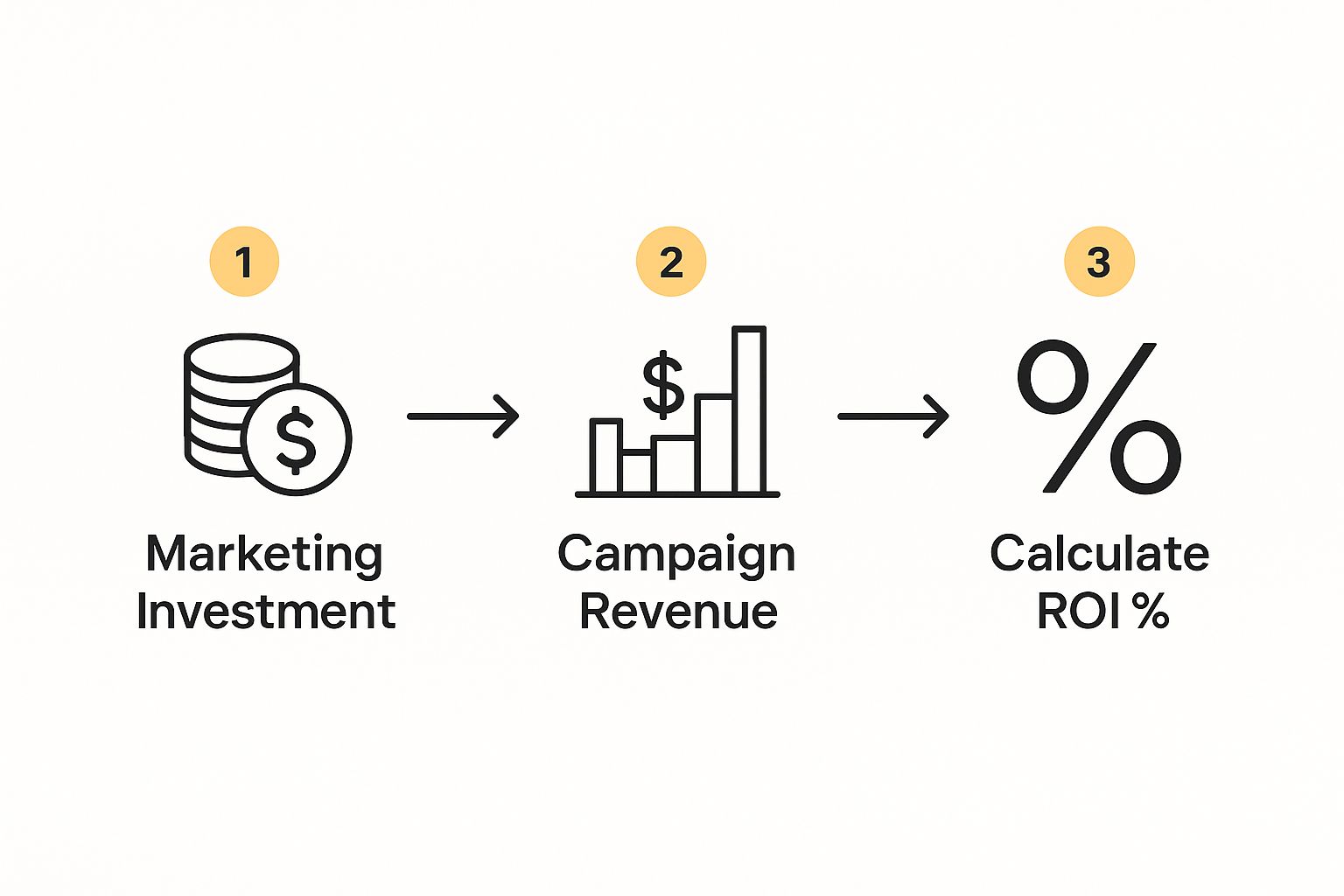Measuring your return on marketing investment, often just called ROMI, is how you figure out the revenue you're generating from your marketing campaigns compared to what they cost you. It’s the clearest way to prove that your marketing efforts are directly contributing to the company's financial health, not just acting as another expense on the books.
Why Measuring Your Marketing Investment Is Crucial
Let's be direct: trying to justify your marketing budget without hard numbers is a losing battle. The days when marketing could get by on gut feelings and creative flair alone are long gone. Today, every dollar spent has to be accountable, turning marketing into a performance-driven machine that speaks the universal language of revenue and profit.

Measuring your marketing investment isn’t just a "nice-to-have" anymore; it’s a fundamental part of the job. Without it, you’re flying blind, unable to tell which channels are driving growth and which are just burning through cash.
Before we get into the weeds, let's break down the core components. This table gives you a quick summary of what goes into a solid ROMI calculation.
Core Components of Return on Marketing Investment
| Component | What It Means | Why It Matters |
|---|---|---|
| Marketing Investment | The total cost of a campaign, including ad spend, creative, and staff time. | This is the "cost" part of the equation. You need an accurate total to measure against. |
| Sales Growth | The increase in revenue directly tied to your marketing efforts. | This is the "return." It's the tangible financial impact of your work. |
| Customer Lifetime Value (CLV) | The total revenue you can expect from a single customer over time. | This helps you understand the long-term value, not just the initial sale. |
| Attribution Modeling | The method used to assign credit for a sale to different marketing touchpoints. | Without this, you're guessing which channels actually drove the conversion. |
Getting a handle on these four pillars is the first step toward building a measurement framework that actually works.
The Growing Pressure for Accountability
The demand for clear ROI is only getting more intense. Back in 2018, about 68% of marketing leaders said demonstrating ROI was a top priority. Fast forward to 2023, and that number has jumped to 83%—a massive shift toward accountability.
What's more, 64% of companies now base their future marketing budgets on past ROI performance. This means your ability to accurately measure return on marketing investment directly impacts your team's resources and how much influence you have in the company.
"Good marketing isn't just about telling compelling stories; it's about delivering measurable results. ROMI is the bridge between creative campaigns and bottom-line business impact."
Beyond Budget Justification
While getting your budget approved is a huge win, the real power of calculating ROMI goes much deeper. It empowers you to make smarter, data-driven decisions that fuel growth and make your team more efficient.
When you consistently measure ROMI, you can:
- Allocate Resources Effectively: You'll have the confidence to shift spending away from underperforming campaigns and double down on the ones delivering the highest returns.
- Optimize Your Strategy: By identifying what truly works, you can refine your messaging, channels, and tactics for even better results. For a deeper look at this, check out our guide on how to measure digital marketing success.
- Align with Business Goals: This practice connects your marketing activities directly to the big-picture objectives, like revenue growth and customer acquisition, that the C-suite actually cares about.
- Foster a Culture of Performance: When the entire team is focused on delivering a positive return, it encourages innovation, accountability, and a healthy dose of competitive spirit.
Ultimately, mastering the art of measuring return on marketing investment transforms your department. You stop being seen as an expense and become a proven, indispensable growth engine for the entire business. It's the key to earning your seat at the strategic table.
Building Your Foundation for Accurate Measurement
Calculating your return on marketing investment is flat-out impossible without clean, reliable data. Any formula is only as good as the numbers you plug into it, so getting your data infrastructure right isn’t just a preliminary step—it’s the most critical part of the whole process.
Without it, you’re just guessing.
This whole foundation starts by ditching vague marketing goals. Objectives like "increase brand awareness" sound nice in a meeting, but they're a nightmare to measure accurately. You need to shift your focus to specific, quantifiable outcomes that tie directly to business results.
Define Your Key Performance Indicators
Before you even think about tracking, you have to decide what success actually looks like for each campaign. Your Key Performance Indicators (KPIs) are the specific metrics that tell you if you're hitting those goals. To really nail your ROMI measurement, you first have to get a handle on the key digital marketing performance metrics available.
Forget the broad targets. You need to define concrete KPIs like these:
- Customer Acquisition Cost (CAC): The total cost to get one new paying customer. Simple and powerful.
- Conversion Rate: The percentage of people who take the action you want, whether that's buying a product or signing up for a demo.
- Lead-to-Customer Rate: This one is huge for B2B companies with longer sales cycles. It's the percentage of leads that actually turn into paying customers.
- Average Order Value (AOV): The average amount a customer spends every time they place an order.
When you focus on metrics like these, you create a crystal-clear line between your marketing activities and the company's bottom line. Every campaign should have one primary KPI that lines up with its main goal. That way, every dollar you spend is measurable from the get-go.
Implement Robust Tracking Mechanisms
Once you know what you’re measuring, it’s time to set up the tech to actually capture the data. This is where a lot of marketers stumble, and it leads to garbage ROMI calculations down the road. A solid tracking system lets you follow a customer’s journey from their very first click to the final sale.
Start with the essentials. First, use UTM parameters for every single link you put out there. These are simple little tags you add to your URLs that tell your analytics tools exactly where your traffic is coming from—a specific email, a Facebook post, a Google Ad, you name it. This simple habit gets rid of the guesswork and lets you attribute wins to the right channels.
Next, make sure your website has conversion pixels and event tracking set up correctly. A pixel from a platform like Meta or Google Ads tracks what users do after they click your ad, like adding something to their cart or making a purchase. This is how you directly connect ad spend to real conversions. In the same way, setting up goals in Google Analytics 4 for things like form submissions or PDF downloads gives you a clear picture of what people are actually doing on your site.
The goal here is to create a seamless flow of data. Your website analytics, your ad platforms, and your CRM should all be talking to each other. This creates a single source of truth and gives you a complete, end-to-end view of the customer journey.
This unified setup breaks down the data silos that kill accuracy. When your CRM knows which marketing campaign brought in a lead, and your analytics platform can track that same lead's behavior on your site, you can measure the true impact of your marketing spend. This kind of meticulous setup is what separates teams with a vague idea of their performance from those who can confidently walk into a meeting and prove their value.
The Essential Formulas for Calculating Marketing ROI
Once you've got clean data and clear goals, it’s time to actually run the numbers. Calculating your marketing return isn't nearly as scary as it sounds. With a couple of key formulas, you can start translating campaign performance into the one language everyone in the business understands: revenue. Before getting too deep in the weeds, it's a good idea to understand what Return on Investment (ROI) is and how to use it.
The most direct way to measure your return on marketing investment is with the classic ROMI formula. It's a simple, powerful tool that gives you a quick snapshot of a campaign's profitability.
The calculation is pretty straightforward:
(Sales Growth from Marketing - Marketing Cost) / Marketing Cost
To turn that into a percentage, just multiply the result by 100. A positive number means your campaign made more money than it cost. A negative one means it was a loss. Simple as that.
Putting the Basic Formula into Practice
Let's walk through a real-world scenario. Imagine an e-commerce brand that sells handcrafted leather goods. They decide to run a targeted Facebook ad campaign to promote a new line of wallets.
Here’s a breakdown of their numbers:
- Total Marketing Cost: $5,000 (This covers ad spend, creative design, and a slice of the marketing manager's time).
- Total Revenue from Campaign: $20,000 (Tracked via UTM parameters and the Facebook pixel).
- Gross Profit Margin: 60% (This is critical—using profit, not just revenue, gives you a much truer picture of performance).
First, let's figure out the gross profit from the campaign: $20,000 (Revenue) * 0.60 (Margin) = $12,000.
Now, we just plug those numbers into the formula:
($12,000 - $5,000) / $5,000 = 1.4
To get the percentage, multiply by 100: 1.4 * 100 = 140%. This campaign delivered a 140% return on investment. In other words, for every $1 they spent, the company generated $1.40 in pure profit.
This visual shows just how simple the flow can be when you have the right data points.

As you can see, the path from spending to calculating your return is a clear, linear process once you have your data sorted out.
Moving Beyond Simple ROMI with Ratios
Another really effective way to frame your results is by using a simple ratio of revenue to marketing costs. This approach gives you an immediate, easy-to-understand benchmark. For example, a 5:1 ratio is often considered pretty good, while an excellent campaign might hit 10:1.
This just means that for every dollar you spent on marketing, the company generated five (or ten) dollars in revenue.
This ratio-based approach is a lifesaver when you're talking to stakeholders who aren't swimming in marketing jargon. Saying "we achieved a 7:1 return" often lands with more impact than "our ROMI was 600%."
Incorporating Customer Lifetime Value for a Deeper View
The basic formula is great, but it has one major limitation: it only looks at the immediate return from a single campaign. It completely ignores the long-term value a new customer brings to your business.
This is where Customer Lifetime Value (CLV) changes the game.
By factoring in CLV, you get a much more sophisticated and accurate picture of your marketing's true impact over time.
Let’s look at a B2B SaaS company that uses content marketing to generate leads for its $500/month software.
- Marketing Cost (Quarterly): $15,000 (This includes writer fees, software, and promotion).
- New Customers Acquired: 15
- Average Customer Lifetime: 36 months
First, let's calculate the Customer Acquisition Cost (CAC):
$15,000 (Marketing Cost) / 15 (New Customers) = $1,000 per customer.
Next, we figure out the CLV:
$500 (Monthly Revenue) * 36 (Months) = $18,000 per customer.
Now, compare the two. The company spends $1,000 to acquire a customer who will generate $18,000 in revenue over their lifetime. The CLV-to-CAC ratio is an incredibly powerful 18:1.
This long-term perspective completely reframes the conversation. A campaign that might look only moderately successful in the short term is revealed to be wildly profitable when you consider the full value of the customers it attracts. This approach is essential for any business with a recurring revenue model, as it justifies investments in slower-burn strategies like SEO and content marketing that build value over the long haul.
Finding the Right Tools for ROMI Analysis
You can't measure what you can't see. That simple truth is why a well-chosen technology stack is your single greatest asset in measuring marketing ROI. Without the right tools, you’re basically flying blind, trying to piece together a puzzle with half the pieces missing.
A solid tech stack pulls all your data points into one place. It creates a single source of truth that shows you the entire customer journey, from that very first click all the way to the final sale. This isn't about hoarding a random collection of software; it's about strategically integrating platforms that actually talk to each other. When they do, you finally break down the data silos that lead to incomplete or just plain wrong ROMI calculations.
Your Core Analytics Platform
Every ROMI analysis needs a central hub for web and app data. For most of us, that's Google Analytics 4 (GA4). Think of it as the foundation for tracking user behavior, conversions, and where your traffic is coming from. It’s the first place you’ll look to see which channels are driving visitors and how those visitors are actually interacting with your site.
Getting GA4 set up correctly from the jump is non-negotiable. This really boils down to two things:
- Configuring Conversion Events: You have to explicitly tell GA4 what a "conversion" means for your business. Is it a product purchase? A demo request? A newsletter signup? Tracking these specific events is how you connect marketing efforts to valuable outcomes.
- Leveraging UTM Parameters: Like we talked about earlier, tagging all your campaign URLs with UTM parameters is critical. It allows GA4 to pinpoint exactly where your traffic is coming from, showing you that a specific email blast or social media post drove a certain number of valuable visitors.
Here’s a look at a pretty standard GA4 dashboard, which highlights key user acquisition and engagement metrics.

From a view like this, you can immediately see which channels are bringing in new users and how engaged they are. This is the raw data that fuels any deeper ROMI analysis.
Connecting Marketing to Sales with a CRM
While GA4 is great at showing you what happens on your website, a Customer Relationship Management (CRM) system tells you what happens after a lead comes in. For businesses with longer sales cycles, platforms like HubSpot or Salesforce are absolutely essential for bridging the gap between a marketing activity and actual revenue.
When you integrate your CRM with your marketing tools, you can finally track a lead's entire lifecycle. You can see that a specific lead who came from a Google Ad eventually became a high-value customer six weeks later. Without that connection, the marketing team gets credit for the lead, but their impact on the final sale gets completely lost in the shuffle.
The real magic happens when your CRM and analytics platform are in sync. This creates a closed-loop reporting system where you can confidently attribute revenue all the way back to the original marketing campaigns that generated the leads.
Leveling Up with Attribution Software
Once you've got the basics down, you might find that standard analytics and CRM tools have their limits. This is especially true when you're trying to understand complex customer journeys with multiple touchpoints before a conversion. That’s where specialized attribution software comes into play.
These platforms are built to go way beyond simple first-touch or last-touch models. They analyze every single interaction a customer has with your brand—from reading a blog post to clicking a retargeting ad—and assign credit more accurately across all those touchpoints. This gives you a much more nuanced and realistic view of how different channels work together to drive sales.
Ultimately, building the right tech stack is a game-changer for any business that's serious about measuring its return on marketing investment. For a practical look at how to get started, check out our guide to data analytics for small business. By integrating these key tools, you can finally move beyond guesswork and start making truly data-driven decisions that prove marketing's value and fuel real growth.
Making Sense of Attribution Models
So, which marketing channel really gets the credit for a sale? This is the million-dollar question that attribution models try to answer. Without a clear way to assign credit, you’re just guessing which efforts are driving revenue, making it impossible to accurately measure your return.
Attribution is all about connecting the dots in a customer's journey. Someone might first find your brand through a blog post on Google, see a retargeting ad on Instagram a week later, and finally click a link in an email to buy something. An attribution model is the rulebook you use to decide which of those touchpoints was most valuable.
Choosing Your Attribution Model
The model you choose directly shapes how you see each channel's performance. There isn’t a single “best” model; the right choice depends entirely on your business, sales cycle, and what you’re trying to achieve. Getting familiar with the common models is the first step. For a deeper dive, our guide on what is marketing attribution breaks it all down.
Most businesses start with one of these common approaches:
- First-Touch Attribution: This model gives 100% of the credit to the very first interaction a customer had with your brand. It’s great for figuring out which channels are best at generating initial awareness and filling the top of your funnel.
- Last-Touch Attribution: The opposite of first-touch, this gives all the credit to the final touchpoint before the conversion. It’s simple to track and clearly shows which channels are effective at closing deals.
- Linear Attribution: This model spreads the credit evenly across every single touchpoint. It acknowledges that multiple interactions contribute to the final decision, offering a more balanced, holistic view.
- Time-Decay Attribution: Like the linear model, this one also credits multiple touchpoints. However, it gives more weight to the interactions that happened closer to the conversion, working on the assumption that more recent touchpoints are more influential.
Simpler models like first-touch or last-touch are easy to set up, but they can paint a dangerously incomplete picture. Over-relying on them might lead you to undervalue channels that play a crucial role in the middle of the journey, like content marketing or social media.
For any business with a longer, more complex sales cycle, a multi-touch attribution model is almost always the better choice. It gives you a far more realistic and nuanced understanding of how all your marketing activities work together.
To help you decide, here's a quick breakdown of how these models stack up.
Comparison of Common Marketing Attribution Models
This table breaks down the different attribution models to help you understand which one best fits your business goals and customer journey.
| Attribution Model | How It Works | Best For | Potential Drawback |
|---|---|---|---|
| First-Touch | Assigns 100% credit to the first marketing touchpoint a customer interacts with. | Businesses focused on top-of-funnel growth and lead generation. | Ignores all subsequent interactions that nurture the lead and close the sale. |
| Last-Touch | Assigns 100% credit to the last marketing touchpoint before a conversion. | Businesses with short sales cycles and a focus on bottom-of-funnel conversions. | Devalues channels that build initial awareness and consideration. |
| Linear | Distributes credit equally among all touchpoints in the customer journey. | Long sales cycles where every interaction is considered valuable. | Can treat all touchpoints as equal, even if some were more influential. |
| Time-Decay | Gives more credit to touchpoints that occurred closer in time to the conversion. | Businesses where momentum and recent interactions are key drivers of a sale. | May undervalue early-stage awareness channels that start the journey. |
Ultimately, the goal is to pick a model that reflects how your customers actually behave, not just the one that's easiest to implement.
Calculating Channel-Specific ROMI
Once you have a handle on attribution, you can start calculating the return for individual channels. This is where you find your true workhorses—the channels that consistently deliver the highest returns and deserve more of your budget. The process is all about isolating the costs and returns for each specific channel.
Let's look at a few practical examples.
Pay-Per-Click (PPC) Campaign ROMI
PPC is often one of the easiest channels to measure because the costs and conversions are so direct. Imagine you run a Google Ads campaign with a total spend of $2,000. Through conversion tracking, you can attribute $8,000 in direct revenue to that campaign.
The calculation is straightforward:
($8,000 Revenue - $2,000 Ad Spend) / $2,000 Ad Spend = 3
Multiply by 100 to get the percentage, and your ROMI is 300%. This tells you that for every dollar you spent, you generated three dollars back in profit.
Search Engine Optimization (SEO) ROMI
Measuring the return on SEO can be trickier because it's a long-term game. Your investment includes costs like content creation, technical audits, and link-building. The return is the value of the organic traffic and conversions generated over time.
For instance, say you invest $10,000 in SEO over six months. During that time, your organic traffic generates 500 new leads. Your lead-to-customer conversion rate is 10%, which gives you 50 new customers. If your average customer lifetime value (CLV) is $1,500, the total value is:
50 Customers * $1,500 CLV = $75,000
Your ROMI would be:
($75,000 Value - $10,000 Investment) / $10,000 Investment = 6.5 or 650%
Email Marketing ROMI
Email marketing consistently stands out as a high-performance channel. On average, it delivers a return of around $42 for every $1 spent, making it a remarkably effective tool for nurturing leads and driving sales.
Let's say you spend $500 on an email marketing platform and staff time for a specific campaign. That campaign directly generates $15,000 in sales.
The ROMI calculation would be:
($15,000 Sales - $500 Cost) / $500 Cost = 29, or 2900%
This channel-specific analysis is what allows you to stop making broad assumptions and start making sharp, data-driven decisions about where to put your resources for maximum impact.
Common Questions About Measuring Marketing Investment
Even with the best formulas and tools, measuring your return on marketing investment can throw some curveballs. This is where theory crashes into reality, and the questions that pop up rarely have simple, one-size-fits-all answers. We've gathered some of the most common hurdles marketers run into and broken them down with clear, practical advice.

Let's dig into the questions that can make or break your measurement framework, so you can navigate the gray areas with confidence.
How Do You Measure ROI for Long-Term Plays like SEO?
This is one of the biggest challenges we see. The return from strategies like SEO or content marketing isn't immediate. It's not like a PPC campaign where you see results in days; SEO builds value over months or even years. The trick is to shift your perspective from short-term revenue to long-term value creation.
Instead of hunting for a direct sale from a single blog post, you have to track leading indicators and attribute value over a longer timeline.
- Track Organic Lead Value: Measure the number of qualified leads coming from organic search. Then, assign a monetary value to each lead based on your historical lead-to-customer conversion rate and average deal size.
- Monitor Keyword Rankings for High-Intent Terms: An improvement in ranking for a keyword like "emergency plumbing services" has obvious commercial value. You can estimate its worth by looking at what you would have paid in cost-per-click for that same traffic.
- Use Customer Lifetime Value (CLV): For customers acquired through organic search, their entire lifetime value should be attributed back to your SEO efforts. This paints a far more accurate picture of SEO's real contribution to the business.
Ultimately, measuring SEO ROI is about connecting your investment to the pipeline it builds, not just the sales it closes today.
What Are the Biggest Mistakes People Make When Calculating ROMI?
Getting an accurate read on your return often comes down to avoiding a few common pitfalls. These mistakes can seriously skew your numbers and lead to some pretty bad strategic decisions down the road.
The most frequent errors we see are:
- Ignoring All Costs: Lots of marketers only count direct ad spend. They forget about crucial costs like staff salaries, software subscriptions, and creative production fees. A true ROMI calculation must include the total marketing investment.
- Using Revenue Instead of Profit: A campaign might generate $10,000 in revenue, but if your product has a 20% profit margin, the actual gain is only $2,000. Using gross profit gives you a much more honest assessment of how profitable your efforts really are.
- Relying on Flawed Attribution: Just defaulting to a simple last-touch attribution model is a classic mistake. It makes you undervalue the channels that build initial awareness and nurture leads, which often leads to cutting budgets for essential top-of-funnel activities.
The single biggest mistake is failing to create a unified view of your data. When your marketing platforms and CRM don't talk to each other, you create data silos that make accurate, end-to-end measurement impossible.
How Often Should I Report on Marketing ROI?
The right reporting cadence really depends on your sales cycle and the marketing channels you're using. If you report too often, you can cause panic over short-term dips. But if you report too infrequently, you might miss key opportunities to optimize.
Here’s a practical guideline that works for most businesses:
- Weekly Dashboards: This is for your team. Focus on leading indicators and channel-specific metrics like click-through rates, conversion rates, and cost per lead. This is for tactical optimization, not for judging the big-picture ROI.
- Monthly ROMI Reports: This is a good rhythm for most companies. It provides enough data to spot meaningful trends without overreacting to daily noise. This report should tie marketing activities directly to pipeline and revenue.
- Quarterly Business Reviews: This is for the C-suite and stakeholders. Use this meeting to present a high-level view of marketing's impact on business goals. This is where you discuss long-term trends, the ROI of bigger initiatives like content marketing, and your strategic plans for the next quarter.
The goal is to find a rhythm that keeps your team accountable and stakeholders informed without creating "analysis paralysis."
Ready to stop guessing and start seeing real returns from your marketing efforts? At Up North Media, we specialize in data-driven SEO and custom web solutions that deliver measurable results. Let us help you build a marketing engine that fuels growth and proves its value every step of the way. Schedule your free consultation today!
